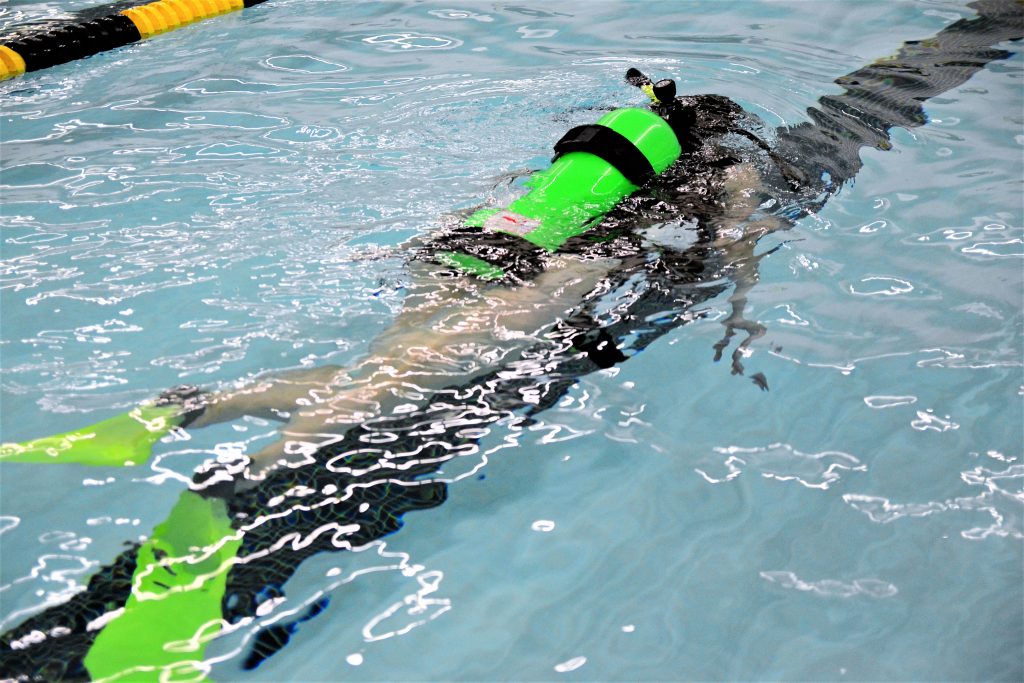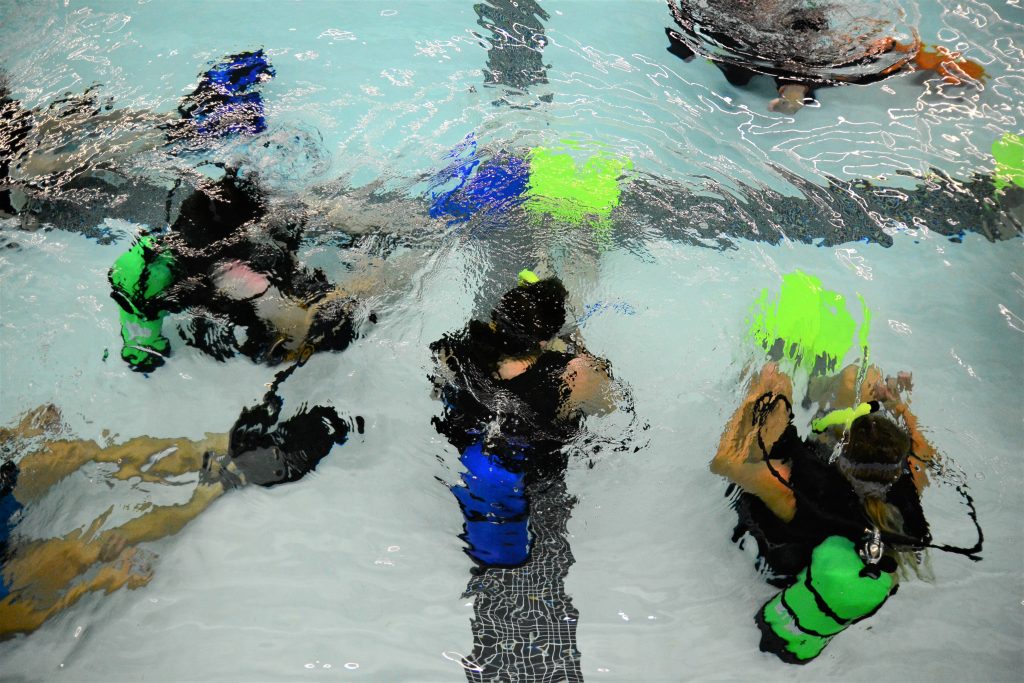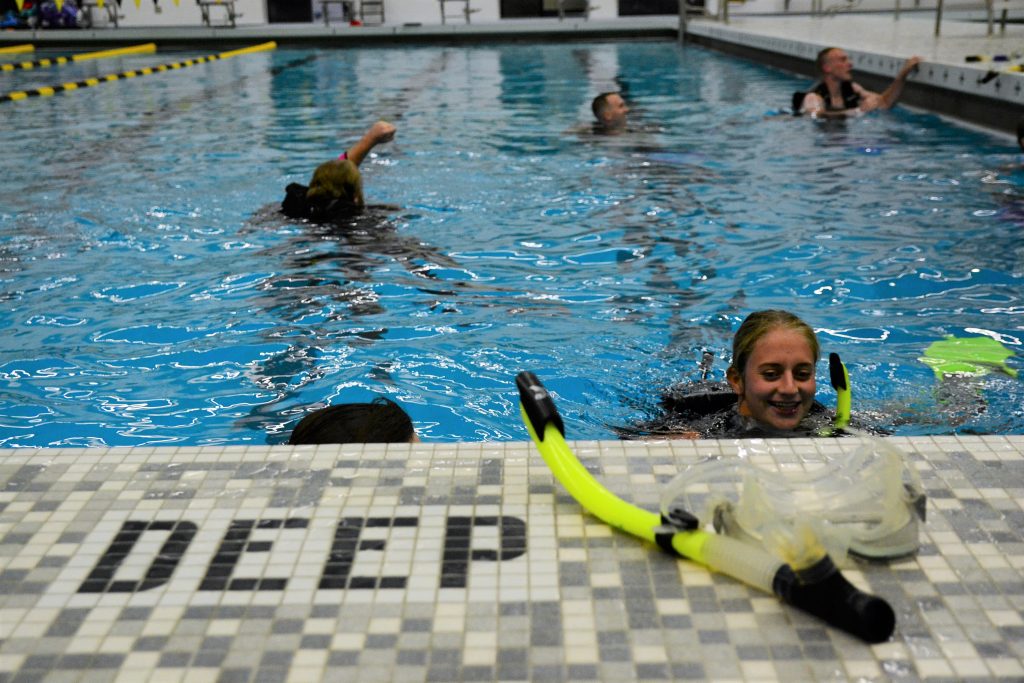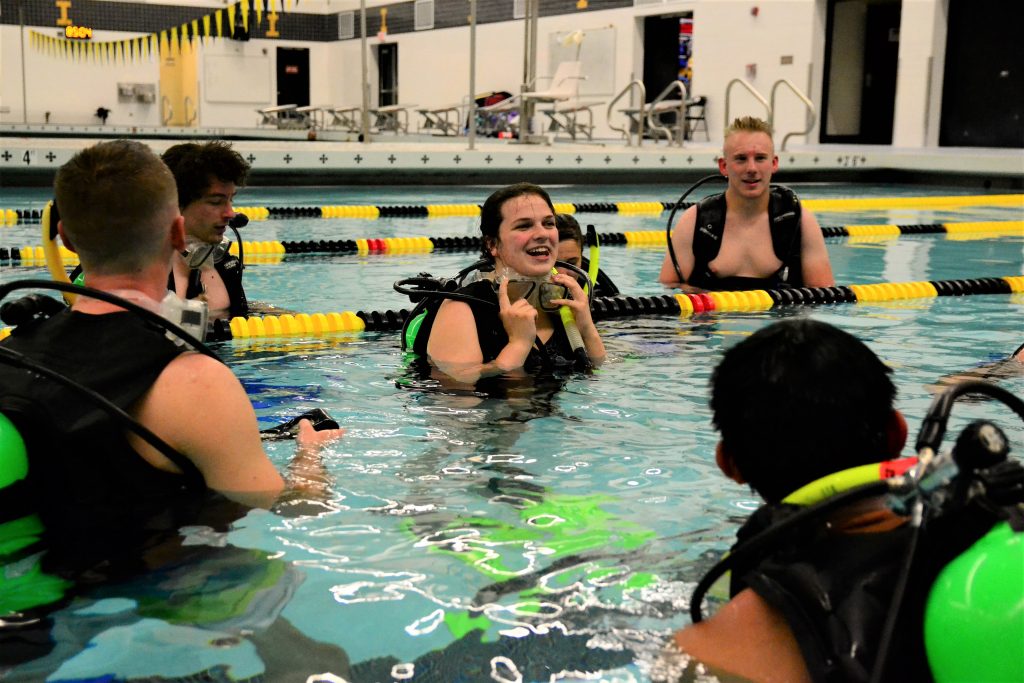Kiara Hauck has always felt safer underwater.
Growing up, her family found a pool, lake, river or ocean wherever they were. And wherever she was — Hauck felt more at ease with waves crashing over her head than anywhere else.
“Water really became a second home for me,” Hauck, a secondary education major at the University of Idaho said. “Whenever I would jump in, all I wanted was to stay submerged and weightless forever.”
She had always wanted to dive deeper underwater, but childhood epilepsy prevented her from being cleared to scuba dive. She tried snorkeling but found herself wanting more.
On a Thursday night under the fluorescent-lit and chlorine-scented university swim center, she hefted 45 pounds of steel and oxygen behind her, jumped in and became indefinitely weightless — at home in the water.
For students in UI’s scuba diving course, scuba is more than a quick check off a bucket list — they come away with not merely the ability to breathe underwater, but with newfound power and confidence, according to Barry Moore, the course’s instructor.
Moore has been teaching people to scuba for 30 years. But he still remembers the first time he went below the surface, and the realization he could stay below.
“I had this epiphany of ‘God, I don’t have to surface,’” Moore said. “My mind was just churning — it was like walking through a door into this whole new world.” Moore has taught the course at UI for ten years, and before that, taught it at Washington State University for close to 20 years. Despite being hundreds of miles from the nearest ocean, he estimates he is certified around 8,000 scuba divers on the Palouse.
“We might be inland, but you’d be surprised where a scuba certification gets you out in the real world,” Moore said. “It shows you’re self-motivated and willing to jump through hoops to get where you want to be.”
Raven Crossley didn’t have any lofty goals for self-discipline or hoops to jump through when she signed up for the course two years ago. Mostly, it was because she didn’t realize Physics 112 wasn’t offered in the fall semester. “I needed those extra credits to graduate, and I thought it might be a fun thing to take my mind off the harder classes,” Crossley said. “I always liked swimming, but I guess I didn’t really know what to expect.”
Now in her second year as a veterinary student at WSU, Crossley returns every week as a teaching assistant for Moore’s class. At the end of her certification, she completed an open-water dive in the Hood Canal and has wanted more ever since.
“Being out in the real underwater world was such an eye-opener,” Crossley said. “I felt so powerful being able to just float there weightless, just because I decided to.”
The 19 students lined up on the bench alongside Hauck in the swim center look like they’re anything but weightless. In pairs, they help each other into buoyancy compensators — inflatable vests that help adjust how you float underwater — and check countless hoses and valves stemming from the bulky air tanks on their backs.
Hauck was buoyant already without even setting foot in the water.
“I just want to get in already,” she said. “I’m so excited. It’s going to be a blast.”
Ian Kessack, a scuba teacher who runs the class along with Moore, instructed the students to put the mouthpiece of the oxygen regulator in their mouths.
The tanks all hissed in startling unison as each student took a deep breath, in and out again.
The students filed over to the pool ladder and lowered themselves down, bobbing expectantly in the shallow end of the pool as they waited for Kessack’s instruction. He demonstrated some simple sign language for underwater communication — finger and thumb circled together like you’d gesture to a waiter is “all good,” for example — and they descended together.
For 20 minutes, they were a school of fish, darting back and forth, moving in concert. Bubbles from their masks rose to the surface, obscuring the world beneath.
It may have been only a shallow, chlorinated pool with a high school swim team practicing 20 feet away, but a door had opened somewhere.
“My favorite part of teaching is seeing their first time on scuba,” Moore said. “There’s always a confidence and growth that happens after that, after you confront something that makes you panic, and you overcome it.”
Hauck emerged from the pool, breathless and shivering a little.
“I wasn’t nervous at all, really,” she said. “It was incredible. Like floating on air. But I needed more weights — I was floating a little too much.”
The students helped extricate each other from the octopus-like tanks and vests. Starting towards the deep pool for a dive without the gear, they chattered and laughed, recounting minor challenges with their tanks. Soon enough, they would find a whole new world waiting for them.
To Crossley, scuba was more than a challenge or a fun diversion from physics classes. She found a refuge beneath the water — a zen experience, floating suspended from worry.
“You forget about the rest of the world under there,” Crossley said. “I just can’t describe that feeling. It’s how I pretend I can fly.”
Story by Riley Haun
Photos by Cody Allred
Design by Trent Anderson




